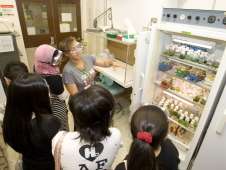NASA Receives Science Results from Orchard Middle School Students

(�鶹��ԺOrg.com) -- Motivating students to learn science is a problem for many teachers. A problem Ron Hamby, an eighth grade teacher from Orchard Middle School, San Jose, Calif., may have solved for his classroom by employing the Citizen Science program, where volunteers perform real scientific research for real scientists.
After spending three summers working at NASA Ames Research Center at Moffett Field, Calif. and Lawrence Livermore National Laboratory, Calif. in a Student Teacher and Researcher (STAR) training program, Hamby decided to give his students a similar experience in his classroom. Having heard of “citizen science,” projects designed to promote public engagement with research and science, he approached Brad Bebout, a research scientist at NASA Ames and his former STAR mentor, with his idea of producing “real science” results for NASA.
“We were really happy to help Ron, and pleased that we could use our research projects to engage middle school students in STEM (Science Technology, Engineering and Math) activities that draw from, and enhance the science that is being conducted in our labs,” said Bebout.
To help Hamby initiate the program, Bebout developed an algae research project that is relevant to NASA for its long-term space flights. Algae organisms can be used to recycle waste and renew oxygen and food supplies. The students also would benefit by learning basic research techniques in the laboratory, and by having an opportunity to present their research results to NASA scientists.
With Bebout supervising, Hamby secured equipment to set up a laboratory experiment for his students. The project used various strands of algae and cyanobacteria, such as Dunaliela, Synechocystis and Chlorella to determine the photosynthetic efficiency of these cultures. Students were given multiwell plates, similar to those used by Bebout, to study the effects of microgravity and cosmic radiation on these organisms.
After weeks of work, Hamby and his students met with NASA scientists to report their results. At the end of his students’ presentation, he asked, “What is the most important thing you learned from this real science research project?” “Take good notes!” “Record data and errors, too!” “Follow all instructions!” shouted his eighth grade students.
He also asked, “How do you feel about science now, after the experiment?” The answers varied: “Everyone here is so friendly. We thought scientists were evil-looking in their lab coats,” said one student. “We learned why it was called research,” said another, a reference to the fact that his experiments had to be repeated. And a young girl in the corner said, “I would like to work here some day.”
Science educators are encouraged to supplement routine lesson plans with “real science” inquiries—that is, experiments that allow students to experience scientific methods and the joy of discovery.
Provided by JPL/NASA















